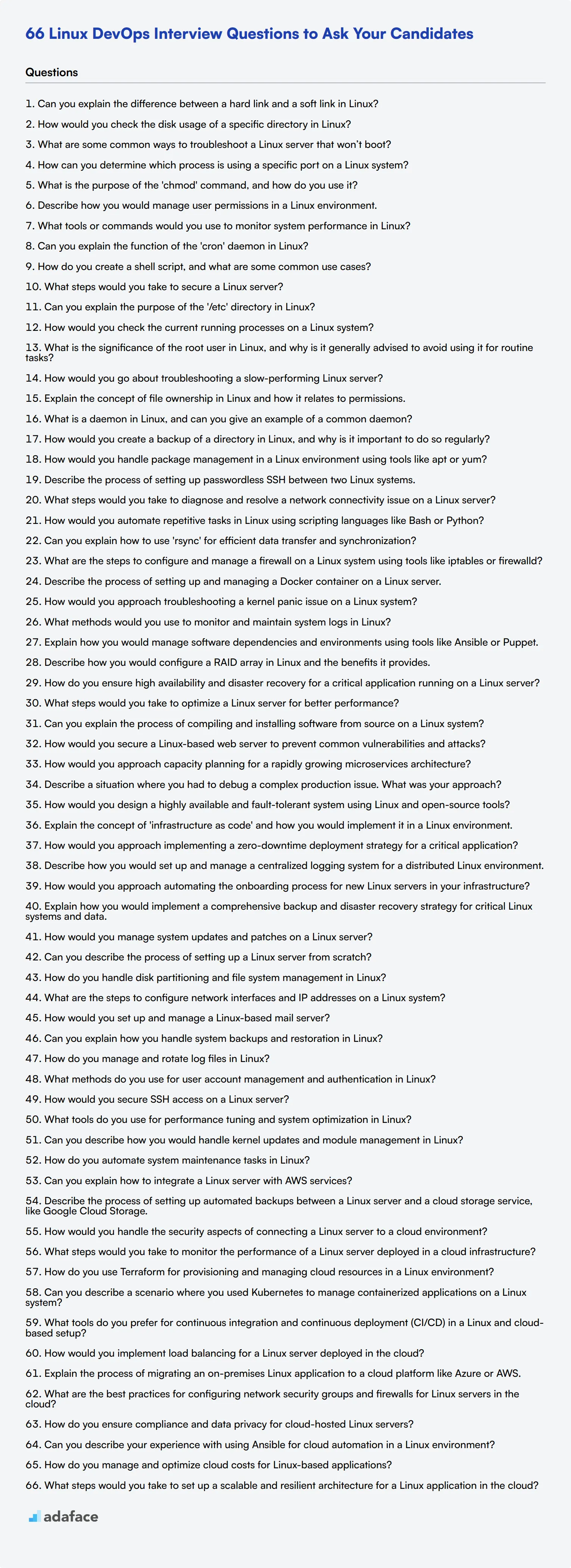In the fast-paced world of Linux DevOps, finding the right talent can be a daunting task for recruiters and hiring managers. Having a well-prepared list of interview questions is key to identifying candidates who possess the necessary skills and experience to excel in this role.
This blog post offers a comprehensive collection of Linux DevOps interview questions tailored for different experience levels, from junior to senior engineers. We've also included questions focusing on system administration and cloud integration to help you assess candidates' expertise across various aspects of Linux DevOps.
By using these questions, you can effectively evaluate candidates' technical knowledge and problem-solving abilities in Linux DevOps. Consider combining these interview questions with a pre-screening assessment to streamline your hiring process and identify top talent more efficiently.
Table of contents
10 common Linux DevOps interview questions to ask your candidates
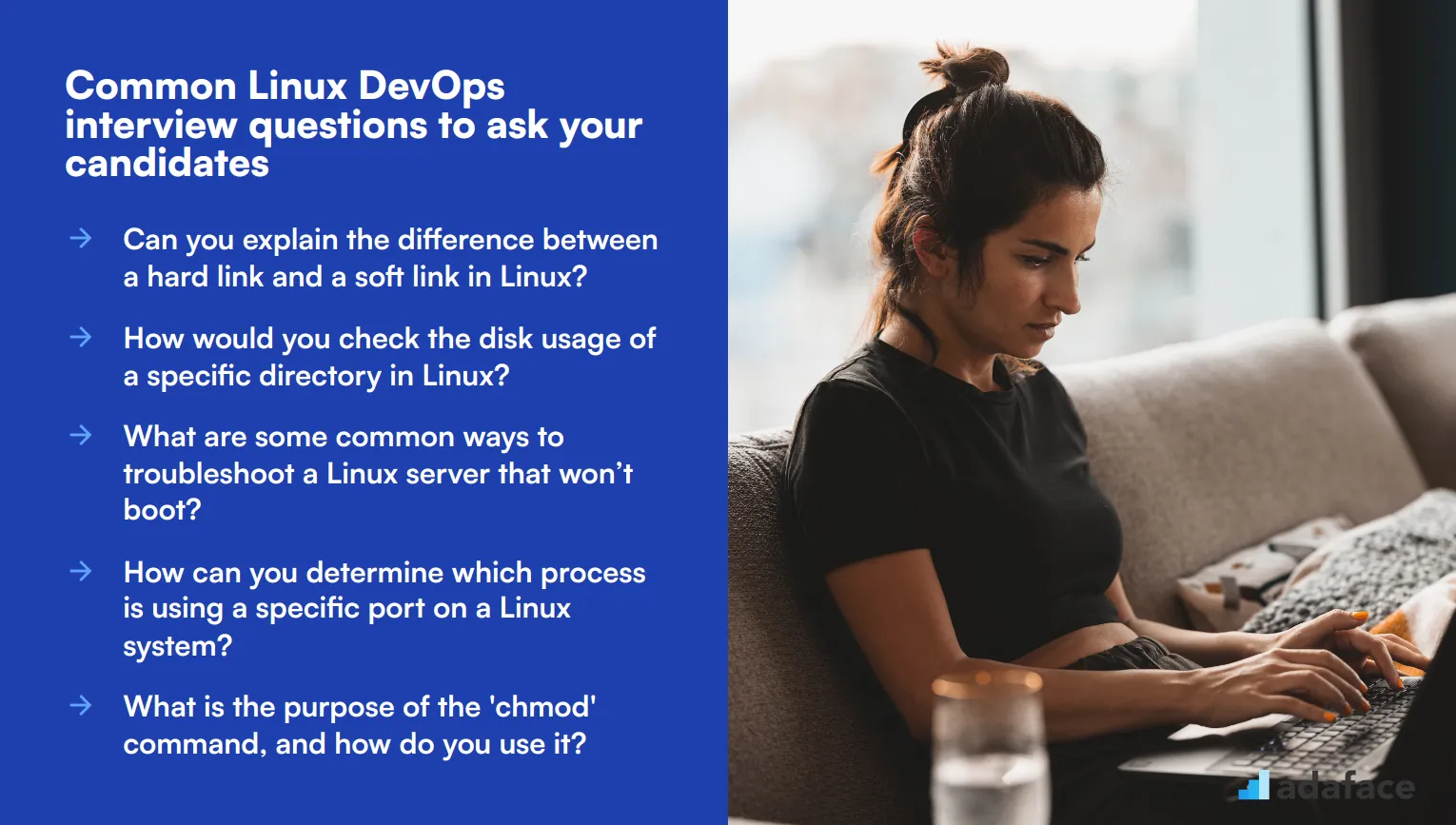
To effectively evaluate your candidates for a Linux DevOps role, consider asking some of these 10 common interview questions. They will help you assess their technical skills, problem-solving abilities, and understanding of essential concepts in the field. For more comprehensive insights, refer to our Linux Administrator job description.
- Can you explain the difference between a hard link and a soft link in Linux?
- How would you check the disk usage of a specific directory in Linux?
- What are some common ways to troubleshoot a Linux server that won’t boot?
- How can you determine which process is using a specific port on a Linux system?
- What is the purpose of the 'chmod' command, and how do you use it?
- Describe how you would manage user permissions in a Linux environment.
- What tools or commands would you use to monitor system performance in Linux?
- Can you explain the function of the 'cron' daemon in Linux?
- How do you create a shell script, and what are some common use cases?
- What steps would you take to secure a Linux server?
7 Linux DevOps interview questions and answers to evaluate junior engineers
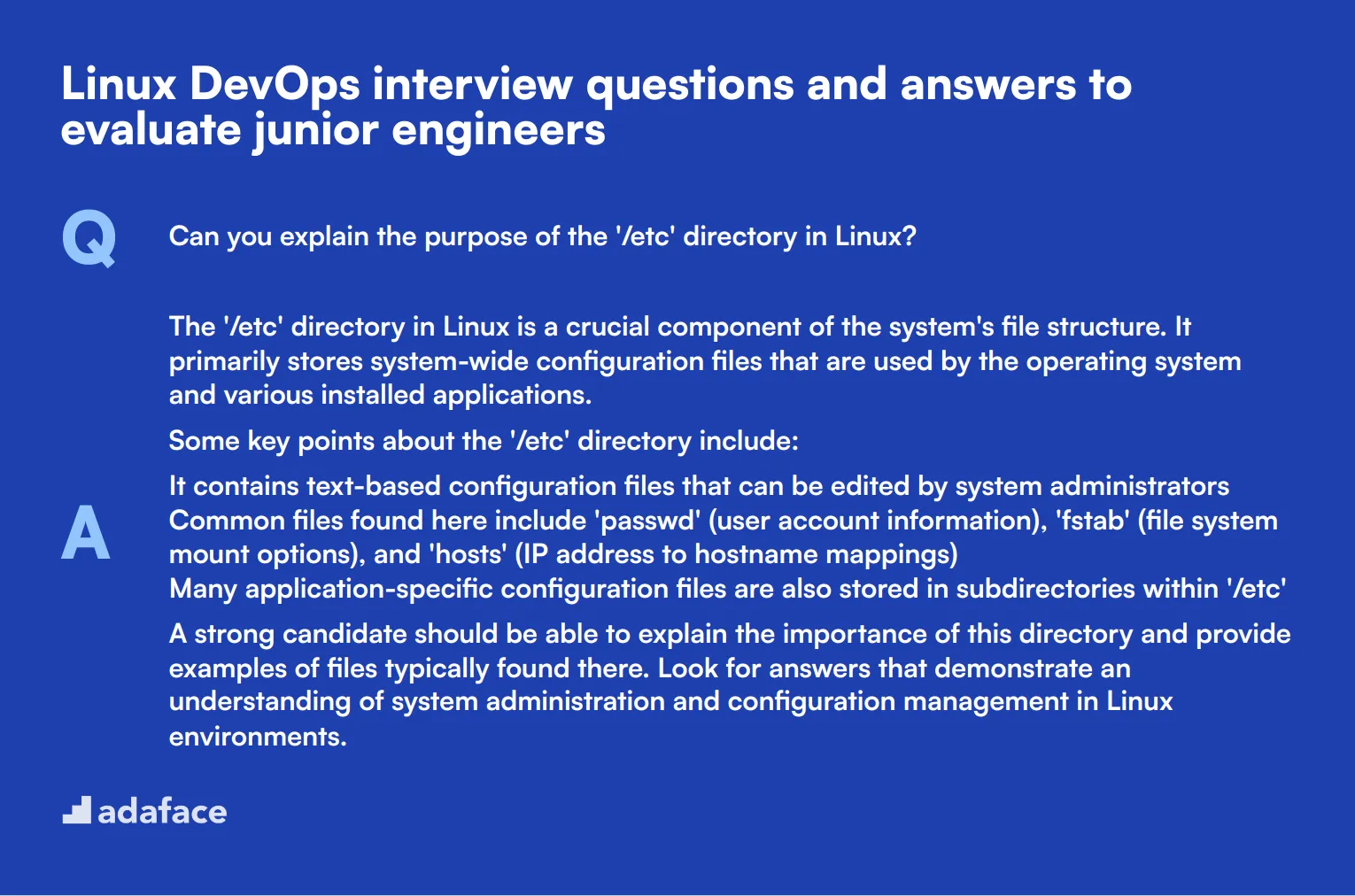
Ready to put your junior DevOps candidates through their paces? These seven Linux DevOps interview questions are designed to help you evaluate the foundational skills and problem-solving abilities of entry-level engineers. Use them to gauge a candidate's understanding of basic Linux concepts and their potential for growth in DevOps roles.
1. Can you explain the purpose of the '/etc' directory in Linux?
The '/etc' directory in Linux is a crucial component of the system's file structure. It primarily stores system-wide configuration files that are used by the operating system and various installed applications.
Some key points about the '/etc' directory include:
- It contains text-based configuration files that can be edited by system administrators
- Common files found here include 'passwd' (user account information), 'fstab' (file system mount options), and 'hosts' (IP address to hostname mappings)
- Many application-specific configuration files are also stored in subdirectories within '/etc'
A strong candidate should be able to explain the importance of this directory and provide examples of files typically found there. Look for answers that demonstrate an understanding of system administration and configuration management in Linux environments.
2. How would you check the current running processes on a Linux system?
To check the current running processes on a Linux system, there are several commands that can be used. The most common ones are:
- 'ps': This command provides a snapshot of the current processes
- 'top': This command gives a real-time, dynamic view of the running processes
- 'htop': An improved version of 'top' with a more user-friendly interface
A good answer should mention at least one of these commands and explain how to use it. For example, 'ps aux' shows all processes for all users in a detailed format.
Look for candidates who can explain the differences between these commands and discuss scenarios where one might be preferred over the others. Strong answers might also touch on how to filter or sort the output to find specific processes or information.
3. What is the significance of the root user in Linux, and why is it generally advised to avoid using it for routine tasks?
The root user in Linux, also known as the superuser, has unrestricted access to all commands and files on the system. It is the most privileged account and has the ability to modify any aspect of the system configuration.
However, using the root account for routine tasks is generally discouraged for several reasons:
- Security risk: A mistake made while logged in as root can have severe consequences for system stability
- Lack of accountability: When multiple administrators use the root account, it's difficult to track who made specific changes
- Potential for accidental system damage: Root access allows for unintended modifications to critical system files
A strong candidate should emphasize the importance of using sudo for administrative tasks instead of logging in as root. They might also mention best practices like creating individual admin accounts for each system administrator to maintain accountability and security in the Linux environment.
4. How would you go about troubleshooting a slow-performing Linux server?
Troubleshooting a slow-performing Linux server involves a systematic approach to identify and resolve the underlying issues. A good answer should outline a step-by-step process, such as:
- Check system resource usage (CPU, memory, disk I/O) using tools like 'top', 'htop', or 'iotop'
- Examine system logs in '/var/log' for any error messages or warnings
- Monitor network activity using 'netstat' or 'ss' to identify any unusual connections or high traffic
- Use 'ps' to identify resource-intensive processes
- Check disk space usage with 'df' and 'du' commands
Advanced candidates might mention additional tools like 'sar' for historical performance data or 'strace' for debugging specific processes.
Look for answers that demonstrate a methodical approach to problem-solving and familiarity with various Linux monitoring and diagnostic tools. The best candidates will also mention the importance of establishing performance baselines for comparison and the need to document findings throughout the troubleshooting process.
5. Explain the concept of file ownership in Linux and how it relates to permissions.
File ownership in Linux is a crucial aspect of the operating system's security model. Each file and directory in Linux is associated with three types of ownership:
- User: The individual user who owns the file
- Group: A group of users with certain shared permissions
- Other: All other users on the system
File ownership is closely tied to the permissions system, which determines who can read, write, or execute a file. The permissions are set separately for the owner, group, and others.
A strong candidate should be able to explain how to view and modify file ownership using commands like 'ls -l' to view permissions and 'chown' to change ownership. They should also understand the concept of the 'chmod' command for changing permissions and how it relates to the numeric (octal) representation of permissions. Look for answers that demonstrate an understanding of how proper file ownership and permissions contribute to system security and user access control in a Linux environment.
6. What is a daemon in Linux, and can you give an example of a common daemon?
A daemon in Linux is a background process that runs continuously, typically handling requests for services or monitoring system events. Daemons are usually started at boot time and run without direct user interaction.
Key characteristics of daemons include:
- They often end with the letter 'd' in their name (e.g., sshd, httpd)
- They don't have a controlling terminal
- They run as child processes of the init process (PID 1)
Common examples of daemons include:
- sshd (Secure Shell Daemon)
- httpd (Apache Web Server Daemon)
- crond (Cron Job Scheduler Daemon)
A strong candidate should be able to explain the purpose of daemons and provide at least one example. They might also discuss how to start, stop, or restart daemons using commands like 'systemctl' or 'service'. Look for answers that demonstrate an understanding of how daemons contribute to the overall functionality of a Linux system and their role in system administration.
7. How would you create a backup of a directory in Linux, and why is it important to do so regularly?
Creating backups in Linux is a crucial task for data protection and system recovery. A common method to create a backup of a directory is using the 'tar' command. For example:
```
tar -czvf backup.tar.gz /path/to/directory
```
This command creates a compressed archive of the specified directory.
Other backup methods include:
- Using 'rsync' for incremental backups
- Employing dedicated backup tools like 'dd' for disk imaging
- Utilizing cloud storage solutions for off-site backups
Regular backups are important for several reasons:
- Data recovery in case of accidental deletion or system failure
- Protection against ransomware or malicious attacks
- Compliance with data protection regulations
- Facilitating system migrations or upgrades
Look for candidates who can explain at least one backup method and understand the importance of regular backups. Strong answers might also touch on backup strategies, such as the 3-2-1 rule (3 copies, 2 different media, 1 off-site), and the importance of testing backups to ensure they can be successfully restored when needed.
15 intermediate Linux DevOps interview questions and answers to ask mid-tier engineers

To ensure your mid-tier engineers possess the right skills and knowledge to manage complex tasks within a Linux environment, use these 15 intermediate Linux DevOps interview questions. These questions are designed to evaluate their technical depth and problem-solving abilities, ensuring they are well-equipped for the demands of the role. For more details on setting up job descriptions, you can refer to our Linux administrator job description.
- How would you handle package management in a Linux environment using tools like apt or yum?
- Describe the process of setting up passwordless SSH between two Linux systems.
- What steps would you take to diagnose and resolve a network connectivity issue on a Linux server?
- How would you automate repetitive tasks in Linux using scripting languages like Bash or Python?
- Can you explain how to use 'rsync' for efficient data transfer and synchronization?
- What are the steps to configure and manage a firewall on a Linux system using tools like iptables or firewalld?
- Describe the process of setting up and managing a Docker container on a Linux server.
- How would you approach troubleshooting a kernel panic issue on a Linux system?
- What methods would you use to monitor and maintain system logs in Linux?
- Explain how you would manage software dependencies and environments using tools like Ansible or Puppet.
- Describe how you would configure a RAID array in Linux and the benefits it provides.
- How do you ensure high availability and disaster recovery for a critical application running on a Linux server?
- What steps would you take to optimize a Linux server for better performance?
- Can you explain the process of compiling and installing software from source on a Linux system?
- How would you secure a Linux-based web server to prevent common vulnerabilities and attacks?
8 advanced Linux DevOps interview questions and answers to evaluate senior engineers
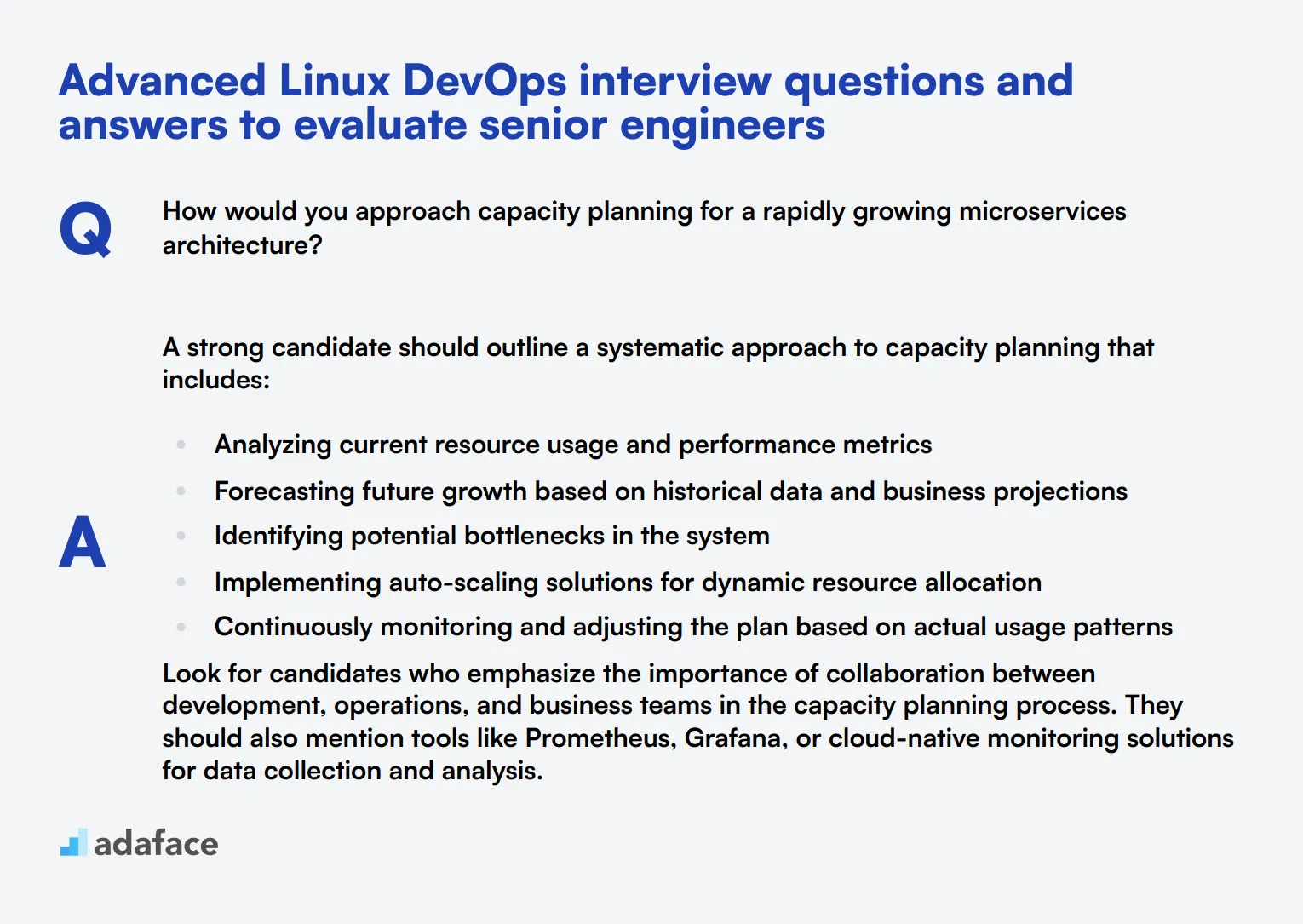
Ready to put your senior DevOps candidates through their paces? These 8 advanced Linux DevOps interview questions will help you evaluate the depth of knowledge and problem-solving skills of experienced engineers. Use these questions to assess candidates' ability to handle complex scenarios and their understanding of DevOps best practices.
1. How would you approach capacity planning for a rapidly growing microservices architecture?
A strong candidate should outline a systematic approach to capacity planning that includes:
- Analyzing current resource usage and performance metrics
- Forecasting future growth based on historical data and business projections
- Identifying potential bottlenecks in the system
- Implementing auto-scaling solutions for dynamic resource allocation
- Continuously monitoring and adjusting the plan based on actual usage patterns
Look for candidates who emphasize the importance of collaboration between development, operations, and business teams in the capacity planning process. They should also mention tools like Prometheus, Grafana, or cloud-native monitoring solutions for data collection and analysis.
2. Describe a situation where you had to debug a complex production issue. What was your approach?
An ideal response should demonstrate a structured approach to problem-solving and highlight the candidate's experience with real-world scenarios. Key points to listen for include:
- Gathering information from logs, metrics, and monitoring tools
- Isolating the problem by reproducing it in a controlled environment
- Using systematic debugging techniques like binary search or divide-and-conquer
- Collaborating with cross-functional teams to gather insights
- Implementing a fix and verifying its effectiveness
- Conducting a post-mortem analysis to prevent similar issues in the future
Pay attention to how the candidate balances urgency with thoroughness, and whether they mention the importance of clear communication throughout the debugging process.
3. How would you design a highly available and fault-tolerant system using Linux and open-source tools?
A comprehensive answer should cover multiple aspects of high availability and fault tolerance, including:
- Load balancing using tools like HAProxy or Nginx
- Clustering solutions such as Pacemaker and Corosync
- Distributed storage systems like GlusterFS or Ceph
- Database replication and failover mechanisms
- Monitoring and alerting systems (e.g., Nagios, Zabbix)
- Automated failover and recovery processes
- Regular backup and disaster recovery planning
Look for candidates who emphasize the importance of redundancy at multiple levels (hardware, network, data) and discuss strategies for minimizing single points of failure. They should also mention the need for thorough testing of failover scenarios.
4. Explain the concept of 'infrastructure as code' and how you would implement it in a Linux environment.
A strong answer should define infrastructure as code (IaC) as the practice of managing and provisioning infrastructure through machine-readable definition files, rather than manual processes. The candidate should discuss benefits such as version control, reproducibility, and scalability.
Implementation details might include:
- Using tools like Terraform, Ansible, or Puppet for infrastructure provisioning
- Storing configuration files in version control systems (e.g., Git)
- Implementing continuous integration and deployment pipelines for infrastructure changes
- Utilizing cloud-init or kickstart for initial system configuration
- Employing configuration management tools for ongoing system maintenance
Look for candidates who emphasize the importance of treating infrastructure code with the same rigor as application code, including code reviews, testing, and documentation. They should also discuss strategies for managing secrets and sensitive information in IaC implementations.
5. How would you approach implementing a zero-downtime deployment strategy for a critical application?
An effective answer should outline a strategy that ensures continuous service availability during updates. Key points to listen for include:
- Using blue-green deployments or rolling updates
- Implementing health checks and readiness probes
- Utilizing load balancers for traffic management
- Employing feature flags or canary releases for gradual rollouts
- Automating the deployment process with CI/CD pipelines
- Having a robust rollback plan in case of issues
Look for candidates who emphasize the importance of thorough testing, including performance and integration tests, before deploying to production. They should also discuss strategies for database schema changes and handling long-running processes during updates.
6. Describe how you would set up and manage a centralized logging system for a distributed Linux environment.
A comprehensive answer should cover the following aspects of centralized logging:
- Choosing appropriate logging tools (e.g., ELK stack, Graylog, or Splunk)
- Configuring log shipping agents on individual servers (e.g., Filebeat, Fluentd)
- Setting up log aggregation and indexing
- Implementing log retention and rotation policies
- Creating dashboards and alerts for important events
- Ensuring secure transmission and storage of logs
- Implementing log analysis for troubleshooting and performance optimization
Pay attention to candidates who discuss scalability considerations, such as using message queues for high-volume environments. They should also mention strategies for handling log format standardization across different applications and systems.
7. How would you approach automating the onboarding process for new Linux servers in your infrastructure?
A strong answer should outline a comprehensive automation strategy that covers various aspects of server provisioning and configuration. Key points to listen for include:
- Using infrastructure as code tools like Terraform or CloudFormation for initial provisioning
- Implementing configuration management with Ansible, Puppet, or Chef
- Utilizing templating systems for consistent server builds
- Automating security hardening and compliance checks
- Setting up monitoring and logging agents automatically
- Integrating with existing CI/CD pipelines for application deployment
- Implementing automated testing to verify server configuration
Look for candidates who emphasize the importance of maintaining an up-to-date inventory system and discuss strategies for handling different server roles or environments. They should also mention the need for proper documentation and version control of the automation scripts and configurations.
8. Explain how you would implement a comprehensive backup and disaster recovery strategy for critical Linux systems and data.
An ideal response should cover multiple aspects of backup and disaster recovery, including:
- Identifying critical systems and data through risk assessment
- Implementing regular full and incremental backups
- Using snapshot technologies for rapid recovery
- Employing off-site or cloud-based backup storage
- Implementing data replication for mission-critical systems
- Regularly testing backup integrity and recovery procedures
- Developing and maintaining a detailed disaster recovery plan
- Setting up automated monitoring and alerting for backup jobs
Pay attention to candidates who discuss the importance of RPO (Recovery Point Objective) and RTO (Recovery Time Objective) in shaping the backup strategy. They should also mention considerations for data encryption, retention policies, and compliance requirements.
12 Linux DevOps questions related to system administration

To effectively assess a candidate's expertise in Linux system administration, use these targeted questions during your interview process. These questions are designed to gauge the candidate’s practical skills and knowledge, ensuring they have the capabilities needed for your Linux administrator role.
- How would you manage system updates and patches on a Linux server?
- Can you describe the process of setting up a Linux server from scratch?
- How do you handle disk partitioning and file system management in Linux?
- What are the steps to configure network interfaces and IP addresses on a Linux system?
- How would you set up and manage a Linux-based mail server?
- Can you explain how you handle system backups and restoration in Linux?
- How do you manage and rotate log files in Linux?
- What methods do you use for user account management and authentication in Linux?
- How would you secure SSH access on a Linux server?
- What tools do you use for performance tuning and system optimization in Linux?
- Can you describe how you would handle kernel updates and module management in Linux?
- How do you automate system maintenance tasks in Linux?
14 Linux DevOps questions related to cloud integration
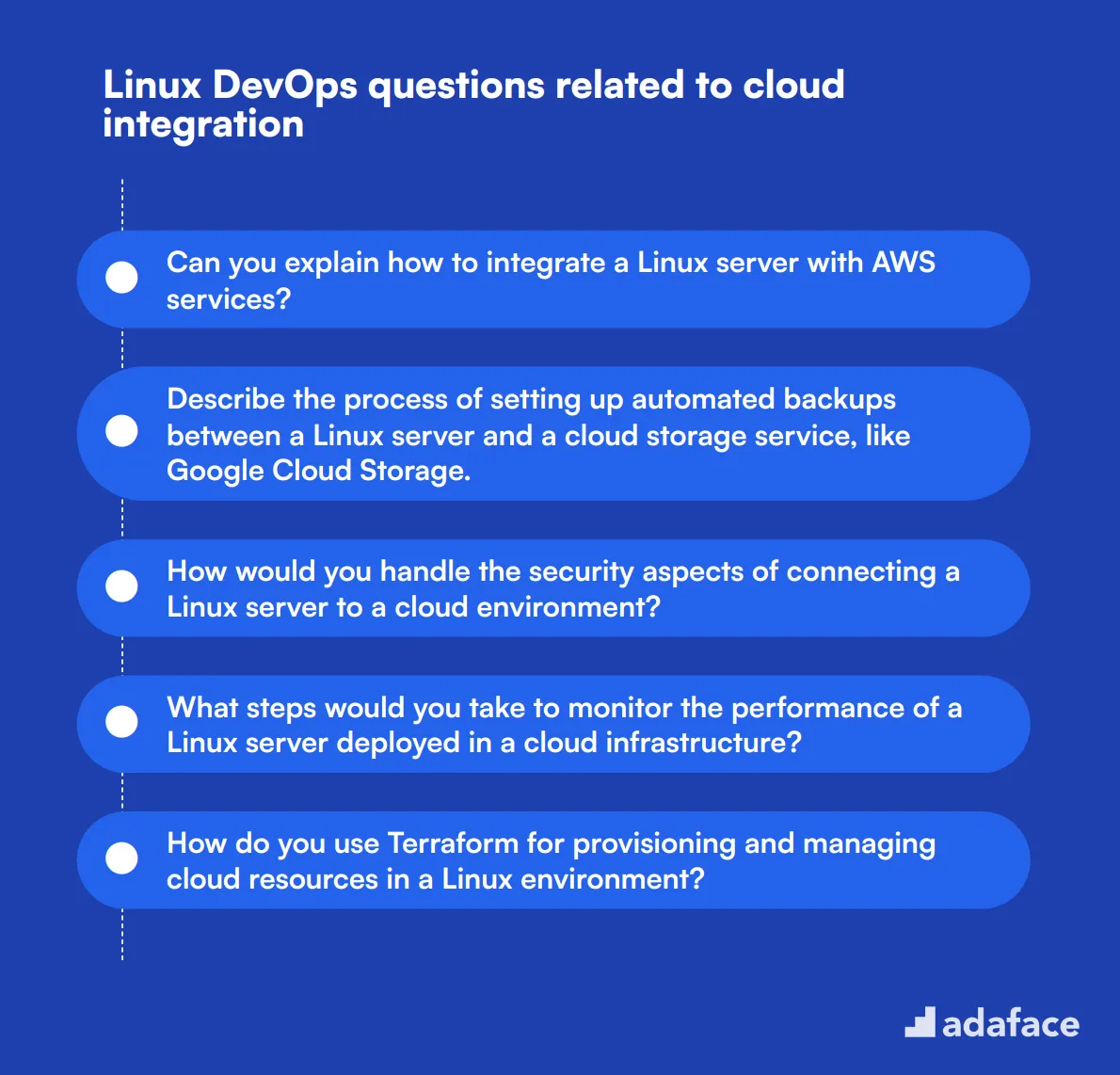
To determine whether your candidates possess the necessary expertise in cloud integration within a Linux DevOps environment, consider asking them some of these targeted questions. These queries are designed to assess their technical proficiency and practical experience in handling cloud-based systems. For a comprehensive understanding, you can also check out this DevOps Engineer Job Description.
- Can you explain how to integrate a Linux server with AWS services?
- Describe the process of setting up automated backups between a Linux server and a cloud storage service, like Google Cloud Storage.
- How would you handle the security aspects of connecting a Linux server to a cloud environment?
- What steps would you take to monitor the performance of a Linux server deployed in a cloud infrastructure?
- How do you use Terraform for provisioning and managing cloud resources in a Linux environment?
- Can you describe a scenario where you used Kubernetes to manage containerized applications on a Linux system?
- What tools do you prefer for continuous integration and continuous deployment (CI/CD) in a Linux and cloud-based setup?
- How would you implement load balancing for a Linux server deployed in the cloud?
- Explain the process of migrating an on-premises Linux application to a cloud platform like Azure or AWS.
- What are the best practices for configuring network security groups and firewalls for Linux servers in the cloud?
- How do you ensure compliance and data privacy for cloud-hosted Linux servers?
- Can you describe your experience with using Ansible for cloud automation in a Linux environment?
- How do you manage and optimize cloud costs for Linux-based applications?
- What steps would you take to set up a scalable and resilient architecture for a Linux application in the cloud?
Which Linux DevOps skills should you evaluate during the interview phase?
While it's impossible to evaluate every aspect of a candidate's abilities in a single interview, pinpointing core Linux DevOps skills can give you valuable insights into their expertise. These skills not only reflect the candidate's technical proficiency but also their ability to thrive in a DevOps environment. Here are the essential skills to consider during the interview phase.
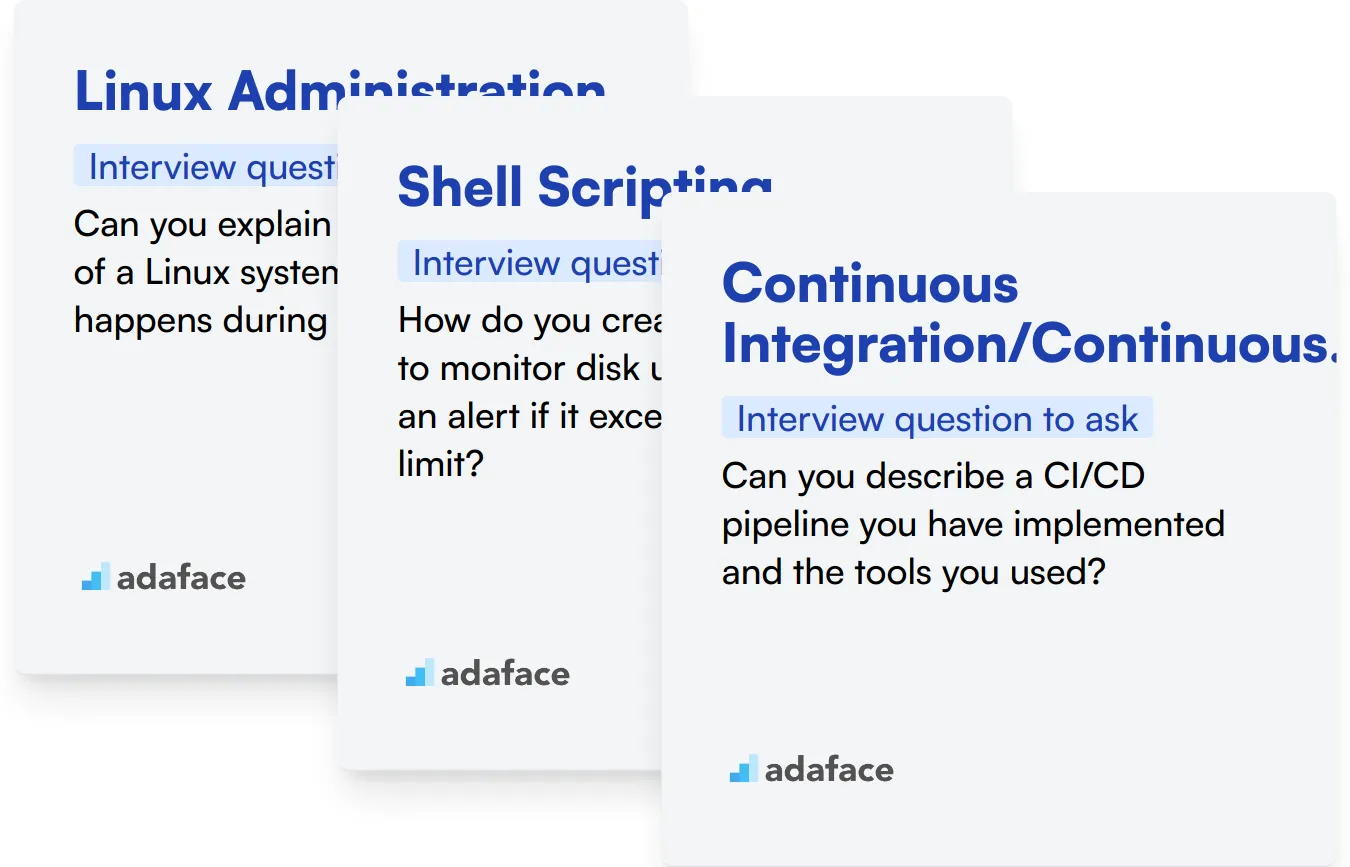
Linux Administration
To gauge their Linux Administration skills, consider using an assessment test that includes relevant MCQs. You might find our Linux Online Test helpful in filtering candidates based on their knowledge.
You can also ask targeted interview questions to assess their Linux Administration skills.
Can you explain the boot process of a Linux system and what happens during each stage?
Look for detailed responses that cover stages such as POST, bootloader, kernel loading, and init process. This demonstrates not only their understanding but also their ability to troubleshoot and optimize system performance.
Shell Scripting
An assessment test that includes multiple-choice questions on Shell Scripting can effectively filter candidates. Consider our Linux Shell Test for this purpose.
Additionally, asking questions specifically related to shell scripting can provide insights into their problem-solving approach.
How do you create a shell script to monitor disk usage and send an alert if it exceeds a specified limit?
Look for candidates who can clearly outline their script structure, including commands like 'df' for disk usage and 'if' statements for conditional checks. This shows practical knowledge and foresight in systems management.
Continuous Integration/Continuous Deployment (CI/CD)
To assess their knowledge of CI/CD, consider utilizing an MCQ test. You can check out our DevOps Online Test for relevant questions.
You can also inquire about their experiences with CI/CD tools during the interview.
Can you describe a CI/CD pipeline you have implemented and the tools you used?
Look for candidates who can discuss real-world examples and how they addressed challenges, showcasing their hands-on experience and understanding of continuous integration and deployment principles.
Streamline Your Linux DevOps Hiring Process with Skills Tests and Targeted Interviews
Hiring the right Linux DevOps professional requires a thorough evaluation of their skills. To ensure you're bringing on board someone with the necessary expertise, it's important to assess their abilities accurately.
One of the most effective ways to gauge a candidate's Linux DevOps skills is through specialized skills tests. Consider using a Linux online test or a DevOps online test to objectively measure their knowledge and abilities.
After candidates complete the skills test, you can shortlist the top performers for interviews. This two-step process helps you focus your time on the most promising applicants, making your hiring more efficient.
Ready to improve your Linux DevOps hiring process? Sign up to access our range of tech assessment tools or explore our IT tests for more options tailored to your needs.
Linux Online Test
Download Linux DevOps interview questions template in multiple formats
Linux DevOps Interview Questions FAQs
The questions cover junior, mid-tier, and senior engineer levels, as well as system administration and cloud integration topics.
Use them to structure interviews, assess candidates' knowledge, and compare responses across different skill levels and specializations.
Yes, the post includes 14 Linux DevOps questions related to cloud integration to help evaluate candidates' expertise in this area.
The post provides 7 specific questions with answers to help assess junior engineers' foundational knowledge and skills.
There are 12 Linux DevOps questions focusing on system administration tasks and knowledge to evaluate candidates' practical skills.

40 min skill tests.
No trick questions.
Accurate shortlisting.
We make it easy for you to find the best candidates in your pipeline with a 40 min skills test.
Try for freeRelated posts
Free resources




